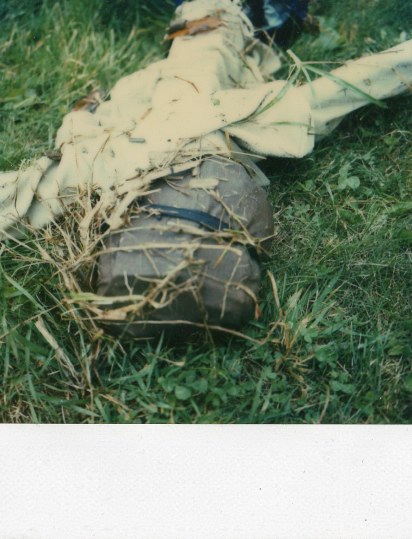Something Frightening But Not Inherently Dangerous
From Amnesty International RI Chapter Newsletter, Dec 1983
PERFORMANCE ART FOR HUMAN RIGHTS
About 2OO people stood near the pond and watched in silence as hooded men roughly threw dimly visible figures to the ground and dragged them to a waiting truck. Working by the light of road flares, the men had filled the truck with prone bodies in fifteen minutes. When the truck disappeared; the red light of the flares remained.
The "death squad" consisted of Bob Rizzo, a RI artist and two assistants. Their victims were forty scarecrow-like effigies created by Bob from sticks and clothing. They were blindfolded to evoke the "disappeared", those whose own governments have sent them to unknown fates. The figures were set at intervals around the campus pond at the Community College of RJ. in Lincoln over the two weeks preceding the mock disappearance on the evening of November 2. During that time Polaroid shots of the figures were displayed with other work of the artist's in the CCRI Gallery nearby. The works were accompanied by text. from Amnesty International country reports and the recorded voices of human rights victims.
This "performance art" was explicitly aimed at raising human rights consciousness among its vi ewers. Bob called upon Amnesty International for some materials. Representatives of Al's Northeastern Regional Office and of Group 49 spoke briefly at a reception following the November 2nd performance.
Bob generously donated one-third of the proceeds of sales from the-show and also solicited donations during the two weeks it was on display.
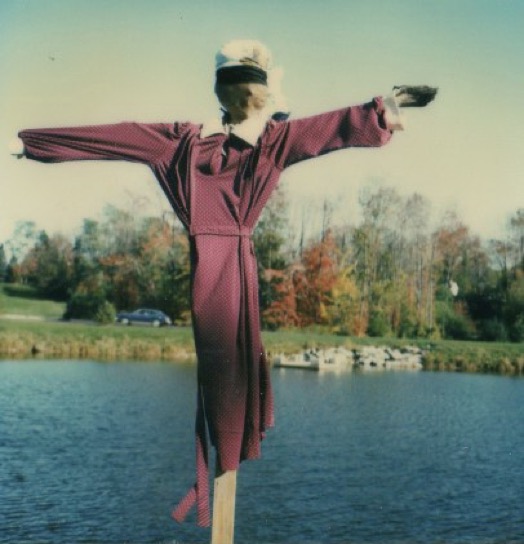
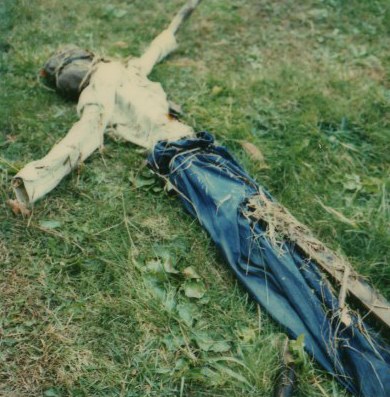
Politics in art
by John Pantalone
Artists know only too well how much politics there is in art. It's the same as any other human endeavor--who you know, what you intend to do, how well you can rub the right palms makes all the difference in the economic world of art. What’s odd about today’s art climate is how little politics there is in the art itself. Twentieth century art has seen wave after wave of art movements that have dealt either directly or by theory with politics and sociology a basic impetus coming from the notion that art could indeed change the world.
The 1960’s and early 1970's evocation of that was as performance art, the avant garde business of confrontation. So much of that early performance work concerned the Vietnam War and social issues, but it eventually evolved into a commentary on the nature of art as just as so much other art did in the twilight of Modernism and the nascence of post Modernism, if you will. The artist who will directly address a political or social concern in his work is a rare bird indeed even more so the performance artist. Providence artist: Bob Rizzo, who has made a career of mixed media presentations built around performance, has planned to show just how rare a species he is when he presents "Something Frightening. But Not Inherently Dangerous” at the Lincoln campus of the Community College of Rhode. Island. Beginning October 1- and extending over a two-week period. Rizzo will build scarecrows which will ring around the pond at the school, the scarecrow was standing in for prisoners of conscience, “the disappeared’ worldwide.
Rizzo, a recent R I. State Council on the Arts grant-in-aid recipient, will conclude. the installation of the scarecrows with an outdoor performance, the full scope of which he hasn't entirely determined. "The idea for the. tree limbs came from something I’d done in 1975 with tree limbs, Rizzo explained. I’ve been interested for some time in doing something with scarecrows and this worked out fine. The Arts Council grant sort of freed me up to say what I wanted, without jeopardizing my situation. I wanted to deal with the Central American--South American problem in an artistic way without going back to the 60's craziness. I wanted to do a 198O's piece""
After reading some material published by Amnesty International, Rizzo decided on the prisoners of conscience motif and decided further to extend the subject worldwide. I contacted Amnesty International and they agreed to collaborate with me on this, " he said. '1 just felt it was time someone did something about this issue.
Artists just aren’t political things anymore. That troubles me. The sense that art has nothing to do with politics just amazes’ me. " As the installation of the scarecrows is proceeding, Rizzo will document them with polaroid photographs, which he will mount in the. CCRI gallery along with text on the subject of political prisoners published by Amnesty International. ' ‘I’m thinking that some of the scarecrows might disappear because that happens a lot with outdoor installations of this nature," he said. ' 'But that’s okay, because then all I’ll have left of their existence is the photo documentation. and that’s quite like what happens to families of prisoners of conscience. Allthey have left is a photograph. "
Rizzo will install five scarecrows a day for 10 days. ''What I can tell you about the performance now is that I will put red flairs in front of each scarecrow, and they'll stay lit for 15 minutes, then go- out. The scarecrows will disappear. There will a1so be audio tapes of released prisoners."
Rizzo said he thinks artists have turned away from inherently political and social subjects to a great degree because art scene "has become a bigger hustle than ever with people trying to make a buck. The loss of much of the National Endowment money has been a cause for that. It really affected the nature of the art being produced. He thinks his installation and performance piece at CCRI will have high visibility in the art community because of his Arts Council grant. 'I may reach people who are interested in seeing what the grant-in-aid guy is doing," he said. “. All I‘m trying to do is get people to look and think about political things."
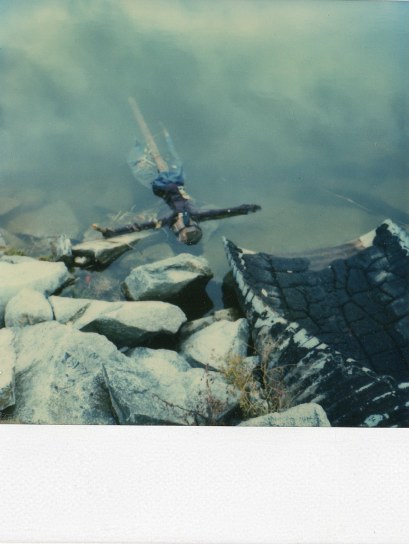
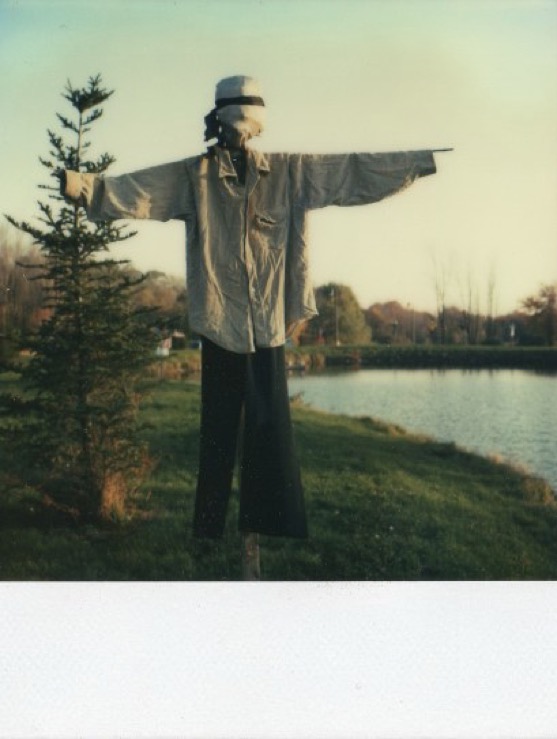
By Russ Olivo
CAll: staff writer
LlNCOLN - Political activism and artistic expression have joined forces at the Community College of Rhode Island where the work of a Providence artist will be on display until tomorrow to draw attention to the plight of the world's "disappeared. “ “The disappeared,” as they are referred to by groups interested in democracy and free speech, is a phrase used to describe those in foreign countries, who have done just that - disappeared – for speaking out against repressive governments. The phrase has special meaning in Argentina. where it was coined as “los desaparecidos”," the disappeared ones.
The injustice of it all is the, subject of an unusual performance art" work by Bob Rizzo. A Providence artist partially supported by the State Council on the Arts, and who is working together with Amnesty International New England office.
It is an unusual artwork because its whole function is to disappear - Like the victims of political repression on all over the world - before the very eyes. of the audience. It 'is art in process" according to Rizzo.
The work consists of several dozen ''scarecrows”- for lack of better word - which Rizzo has built of second-hand clothing and tree branches, and which he has planted in a circular pattern bordering a pond at the entrance of CCRI.
Part of the process of the artwork is the accumulation of more and more scarecrows around the rim of entire pond each day. Yesterday, about 25 scarecrows bordered half the pond, and by tomorrow evening the entire pond is to be lined with scarecrows. The. culmination of the process is tomorrow at 8 p. m. when the scarecrows will be tossed into the rear of a pick-up truck, blindfolded. A burning flare will replace, every missing scarecrow. There will be an accompanying soundtrack. ‘I will make my representatives of the 'disappeared' disappear". explained Rizzo. "They’ll be tossed into the back of a pickup truck the same way a lot of these people are tossed into pickup trucks and driven off,” he said.
Somebody almost brought the show. To a premature end by, tossing several of the scarecrows in the pond last weekend, an act which Rizzo thinks was the result of suspicion about his motives.
While working on the figures, one passerby branded him a communist. Another charged him with committing a sacrilege, probably because the stick-figures resemble crucifixions. The show is titled after the dictionary definition of a scarecrow, “Something Frightening But Not Inherently Dangerous” according to Rizzo.
Rizzo's scarecrows hardly fit into one's traditional idea of the hay stuffed vagabonds which farmers customarily use to ward on crows, however. Rizzo’s creatures have an unsettling air about them, something skeletal. They're just rags draped over branches for arms and legs. But they're still "human."
Rizzo, 36 whose shoulder-length, graying curls, John Lennon eyeglasses and black beret evoke something of the 1960's, says the figures suggest the spiritual condition of the political prisoners of -other countries. in many cases they are tortured or subjected to cruel treatment because they are considered political enemies ·
He says that Amnesty International has provided him, with figures which say that in 1981 there were approximately 13.000 known political prisoners in 15 Latin American countries. In addition. there, were another 3.278 political prisoners executed in· 34 countries and another 2.205 sentenced to death in 52 countries.
"People are murdered all the time for disagreeing with their governments" said Rizzo. When I found out about this I couldn't believe so few people knew what was going on."
Part of the show is to help raise funds for Amnesty International, a watchdog over government excesses or political abuses of power. Rizzo will take snapshots of the scarecrows - the only lasting memory of their existence – for $15 each after the show. That’s $5 for Amnesty International and $10for me." Adding that he hopes to break even on the money he, put into the show.
The photos are currently on display in the Art Gallery of CCRI with text from Amnesty International’s 1982 annual report, describing in detail examples of political repression, torture and imprisonment in countries around the world. The photo display, which Like the outdoor scarecrow population grows daily is another part of the performance art production, according to Rizzo.
The self-taught, artist said he became interested in that form of expression because he found visual art too restrictive. "I had done painting for a number of years and I found that terribly limiting in terms of what I wanted to say,' Rizzo said. Performance art on the other hand uses as many different types of media as one finds necessary and has “no rules”, no limitations according to Rizzo. That's the best part about it”
